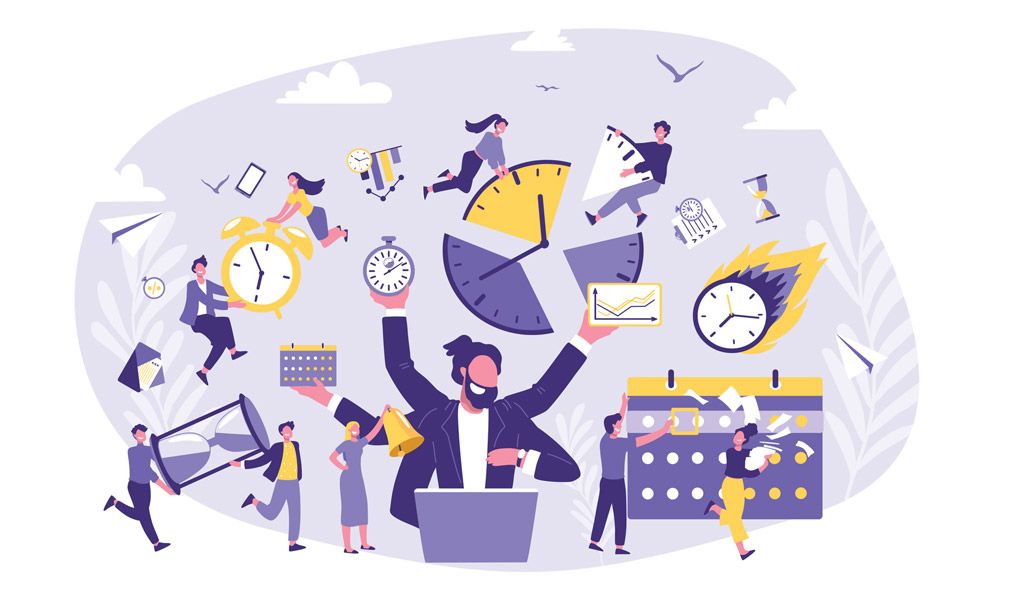Productivity Hacks. There are only 24 hours in a day, and there’s no changing this – unless you plan on moving to planet Venus where the day is longer than the year! We’ve created a list of 7 top productivity hacks that will help maximize your day with this in mind.
1. Deep Work
The term Deep Work was coined by Assistant Professor of Computer Science at Georgetown University, Cal Newport. Newport has published a book with the same title. So, what is deep work? Here’s the definition:
“Professional activities performed in a state of distraction-free concentration that pushes your cognitive capabilities to their limit. These efforts create new value, improve your skill, and are hard to replicate.”
That sounds a little wordy, but don’t worry, we’ll work through it.
First, it’s important to create a distinction between deep work and shallow work. If some work is deep, then other work has to be shallow.
Here are some examples of deep work:
- Creating a new course.
- Researching for a book, article, or paper.
- Preparing for an important meeting.
- Dedicating time to analyzing data.
- Writing a book or other long-form content like articles, scripts, journals.
- Studying.
Here are some examples of shallow work:
- Scrolling social media.
- Speed reading a book or article in a way where you’re not taking everything in.
- Doing simple day to day tasks that you could delegate to others.
- Engaging in little bouts of entertainment like watching short videos between tasks.
- Answering emails
We live in a world where there is an increased need for focus, and yet the ability to focus and give our full attention to a task is diminishing.
Our inability to focus on the task at hand also gets in the way of our happiness. You feel proud when you tackle a task with complete focus because you know you did your best – you brought all your mental faculties to the table. Additionally, when we spend too much time doing shallow work, it eats up our free time and means we’re still working on our tasks later into the day. This is often why you feel like you’ve had a full day and no relaxation time when you reach the end of the day. You didn’t truly enjoy the time you spent on shallow work, and you didn’t focus during your more demanding tasks.
The internet and the rise of on-demand entertainment and social media have created a world where focusing is rare. Today, people are constantly distracted by advertisements, notifications, emails, and other noise.
Benefits of Deep Work
People who engage in more deep work activities are happier than those who primarily engage in shallow work. You also learn difficult things quicker and create to the best of your ability. In his book, Newport argues that deep work is becoming the most valuable asset for workers in today’s knowledge economy. By working intensely, you not only create better work, become smarter and happier, but you also increase your worth in the job market.
How to Get Better at Deep Work
Flow
When you work without distraction, you reach a state of flow. Flow is a state of mind where you become fully immersed in an activity – you are totally focused on what you’re doing and achieve a state of energized focus. You’ve probably also heard it called “the zone.”
Hungarian psychologist Mihály Csíkszentmihályi coined the term flow. He believes that getting into a state of flow makes you happier than having free time. Why? Because work involves goals, rules, feedback, and challenges. We like to accomplish something. By contrast, free time is unstructured, doesn’t have an end goal, and is ultimately unrewarding.
Dedicated Time to Deep Work
Set aside regular time to engage in deep work. During this time, you can’t engage in any shallow work. Put your phone on Do Not Disturb or just put it in a different room entirely. Don’t answer your emails, watch TV, or take breaks.
But how much time? Ideally, you should do deep work in short stints, especially when you’re just starting. For example, you could say that you’re doing deep work between 9 am, and 10 am on Mondays and Wednesdays. Another option is to do a longer stretch but less regularly, for example, 6 hours on the last Friday of the month. One psychologist recommends that beginners should start small and only dedicate one hour. Deep work veterans might go as long as four or more hours.
Pick Your Deep Work Location
The location you pick should be quiet and free from distraction. This means no music, TV, and so on.
Rules of Deep Work
You need to set out the rules for your deep work and hold yourself accountable to them. Some common rules might be:
- No using the internet.
- No using your phone.
- No communicating with other people (phones/text/social media)
- No emails or meetings.
- You must reach X milestone before taking a break.
Depending on what deep work task you want to work on, these rules might look different for you. For example, if you’re researching for a paper, you might need to use the internet. If you find yourself getting regularly distracted by the internet while engaging in deep work, you should consider apps that limit what websites you can access.

2. Overcoming Procrastination With Danger
A lot of productivity hacks are ultimately about ways to overcome your procrastination. One of the significant drivers of procrastinating is anxiety. You don’t want to start a task because, in the back of your mind, you’re worried you can’t do it, you won’t produce good work, or the task seems gargantuan in scale (and again, you think you’re not up to the challenge).
Some people like to introduce a bit of danger into the mix to overcome anxiety. A great example of this is The Most Dangerous Writing App. It’s a website where you select a time, say, 5 minutes, and you have to write continuously for that time. If you pause for too long, everything you have written gets wiped. Sure, you won’t produce your best work using this website, but you will get started. You don’t have time to think; you have to pour the thoughts out of your brain. It’s an excellent way to loosen up before a task, and you’ll often find that even if what you produce isn’t perfect, there’s still material in there you can use.
Another example of this dangerous tactic is commitment contract websites like Stickk.com. This website, and others like it, work like this:
- You pick a goal. For example, lose 5 pounds this month.
- You put down some money, say $50.
- You say what happens to the money if you don’t meet your goal. For example, it goes to a charity you don’t like or to a friend.
This one might not work for everyone because it arguably introduces more anxiety into the mix. However, it’s an excellent idea for many people because it works by reframing the task. You’re no longer wondering how much you’d enjoy an extra chocolate bar; you’re thinking of how much you don’t want to lose $50. With the writing app, you’re not thinking about whether your last sentence was perfect or not; you’re just trying to keep it alive. And before you know it, you’re making progress.
3. Batching
Batching is a productivity process where you put your tasks into categories and tackle one category at a time. The goal of batching is to make you focus entirely on one task without distraction. One study shows that looking at a random email in the middle of a task can rob you of 15 minutes of focus.
There are different ways to do batching. For example, let’s say you make YouTube videos. Instead of doing trying to write your script, edit your script, record the script, and do animations all in one day instead, you could do this:
- Monday – Write the script
- Tuesday – Edit script
- Wednesday – Record script
- Thursday – Animate video
- Friday – Upload
You can do this to work on multiple videos at the same time. So, you could spend all of Monday writing three scripts, Tuesday editing three scripts, and so on. Batching like this helps promote flow.
You can also use batching to organize your day to make it more streamlined. For example, if you need to go for a run, visit the post office, go grocery shopping, and clean the kitchen, you could organize it like this:
Go for a run > visit the post office > go to the shop, bring your post and shopping into the house > unpack your groceries > clean the kitchen because you’re already there!

4. The Pomodoro Technique
There’s a good chance you’ve heard of the Pomodoro technique, but there’s a good reason why – it works. It’s a time management technique, and it works like this:
- Pick a task
- Set a timer – 25 minutes is recommended.
- Focus solely on that task for the allotted time.
- When the timer goes off, write a checkmark on a piece of paper.
- Take a break for 3-5 minutes.
- Repeat steps 2-5 for three rounds. When you have three checkmarks, you can stop.
The Pomodoro technique is a great way to get yourself to work in bursts, knowing that a break is just around the corner. You’re also spurred on by seeing the checkmarks.
5. Pareto’s Law
Pareto’s law states that 80% of the results come from 20% of the effort for a lot of activities. A simple example of this is that 80% of your sales come from 20% of your customers. So how do you turn Pareto’s law into a productivity hack? By deciding what to focus on.
Put simply, most of your results will come from a small number of your efforts, so you need to find what those efforts are. For example, instead of spending equal time with every client, spend more time with your top 5 clients.
To find your high ROI activities, you need to write a list of all of your actions and how much time you spend on them. If you combine this with the Pomodoro technique, you’ll have an accurate picture of how much time each task costs you. At the end of the month, write down what you achieved from each task. Sometimes the results aren’t comparable, and you’ll have to use your intuition. For example, if you spend 20 hours total writing blog posts, and this generates 15 leads, then great. But you can’t compare those 20 hours to 20 hours you spent reading and say, “I should spend 40 hours writing blog posts”. Reading might provide you with the necessary inspiration and added knowledge to write your blog posts.
6. Laborit’s Law
This law states that you should prioritize your most difficult tasks for the beginning of the day. Why? Your brain is fresher at the beginning of the day – Due to the circadian rhythm, your brain is more alert in the morning. The blue light filtering through your window from Sunrise triggers your brain to release hormones that wake you up.
7. Use Your Willpower Wisely
Studies have repeatedly shown that willpower is a finite resource. If you have to use your willpower to resist eating a freshly baked cookie, you will have less willpower when it comes to tackling a difficult task. This is why you should try to do all of your high-effort activities at the beginning of the day and leave easier (but still undesirable) activities until later.




















